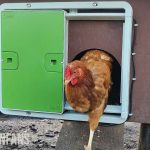Bantam Chicken: A Guide To These Miniature Birds

Bantam chickens are no ordinary chickens! They are the pint-sized superheroes of the poultry world, packed with personality and cuteness. Let’s embark on the world of miniature chickens and discover all the fascinating facts.
What is a Bantam Chicken?
A Bantam chicken is a small version of a regular-sized chicken, usually one-fourth to one-fifth in size. They come in various breeds and are favored as pets. Some Bantams, called ‘true Bantams,’ lack a larger chicken counterpart. Bantams are known for their friendly and cuddly personality.

How Many Eggs Does a Bantam Chicken Lay?
Bantam chickens are not the best egg layers. Not only do they lay small eggs, but they also have the tendency to go broody often, which temporarily stops egg production. On average, Bantam chickens lay around 150-200 eggs yearly, but the exact number depends on the breed.
They are known for their strong maternal instincts and can often be found diligently sitting on a clutch of eggs, eager to hatch and raise chicks. Their nurturing nature adds to their charm as backyard companions.

Are Bantams Chickens with Dwarfism?
Bantam chickens are not considered to have true dwarfism as their smaller size is not caused by a genetic disorder affecting skeletal growth. However, Bantam Dwarfism is linked to several gene mutations that alter skeletal growth and body size phenotypes.
For years, people have associated Bantam Dwarfism with a sex-linked recessive gene on the dw-locus. The specific allele that controls Bantam Dwarfism is noted as dwB and controls dwarfism in, for example, Sebright Bantams.
Recent studies have revealed many more genes associated with genetic bantam variants by using modern techniques such as whole-genome sequencing. Furthermore, the genes involved differ depending on the bantam breed and its origins. [HODF]

This becomes apparent when you cross different bantam breeds. The offspring’s size is sometimes larger than both parent birds. For example, crossing an Orpington Bantam with an Indian Game Bantam can result in F1 birds close to commercial layer size.
Popular Bantam Breeds
Bantam chickens have conquered the hearts of chicken keepers worldwide with their miniature charm and delightful personality. They are great companionship for families with children.
Bantams are beloved for their diverse colors and friendly dispositions. Let’s address some popular choices in Bantam breeds. Each breed offers its own unique characteristics and charm.
Silkie Bantams
Silkies are considered a bantam breed in some countries. They look like fluffy clouds with their soft, silk-like feathers and gentle nature.
Their friendly demeanor and striking appearance, including their black skin and five toes, make them a sought-after choice among bantam enthusiasts.

Cochin/Pekin Bantam
Cochin (also known as Pekin) bantams are heavily feathered chickens. With their profuse plumage covering their legs and feet, they own a charming and gentle disposition.
Cochins come in various colors, adding to their allure as prized bantam chickens.

Serama
Serama bantams are true bantams, meaning they have no large counterpart. They may be tiny in size, but they make up for it with their confidence and boldness.
Originating from Malaysia, these small birds captivate with their upright V-shaped posture, and energetic personalities.

Belgian d’Uccle Bantam
Another true bantam breed is the Belgian d’Uccle Bantam. This breed is adored for its ornate appearance and friendly nature.
With their fluffy feathers, feathered feet, and beards, they bring a touch of elegance to any flock. Their small size and sweet temperament make them ideal for both pet and exhibition purposes.
They are most famous in the millefleur color pattern, meaning ‘a thousand flowers’.

Rosecomb Bantam
Rosecomb bantams are known for their distinctive comb, characterized by a single row of upright, evenly spaced, and neatly folded points.
They come in various colors and have a active nature. Their attractive appearance and lively demeanor make them popular among bantam enthusiasts.

Caring for Bantam Chickens
Bantam chickens have some special care requirements compared to regular-sized fowl. Here are a few considerations to keep in mind:
One important aspect of caring for bantams is their sensitivity to muddy and wet environments. Many bantam breeds have fluffy feathered feet, which can become easily soiled.
This can lead to discomfort and potential health issues like bumblefoot or fungus. To prevent this, it is necessary to provide dry and well-drained areas for bantams.

Additionally, due to their small size, bantams require additional protection from predators. Their small stature makes them more vulnerable to predators. Ensuring their housing is secure and regularly checking for any potential entry points can help safeguard them.
When handling bantams, it’s important to be gentle. Their small size and delicate nature make them more prone to injuries if mishandled. Take care when picking them up or interacting with them to avoid causing stress or harm.
Some Bantam chickens need different roosts than large fowl, remember to place the roosts a bit lower so they can easily hop on and off.
For lightweight bantams slightly higher roosts are not a major issue, but for more heavy bantam breeds, like cochins, jumping of a high roost can cause foot injuries.

Bantams have different social dynamics compared to regular large laying hens. In mixed flocks, bullying can arise due to the size and personality difference.
Never place bantam chickens with assertive or dominant large breeds as they will be bullied. Keep an all bantam flock or with other friendly breeds.
Remember, bantam breeds have specific needs, so it’s always beneficial to research and seek advice from experienced chicken keepers or breed-specific resources to provide the best care for your bantams.
By considering their smaller size, sensitivity to wet conditions, predator protection, gentle handling, and appropriate social dynamics, you can ensure the well-being and happiness of your bantam chickens.
Summary
Bantam chickens are small versions of regular chicken breeds. They are popular as ornamental birds and pets, known for their friendly personalities.
Bantams come in various breeds, each with different colors, feather patterns, and personalities. They lay small eggs and may exhibit broody behavior.
While they have similar care requirements as standard chickens, special attention is needed due to their small size, sensitivity to wet environments, and potential vulnerabilities. Overall, bantam chickens bring charm and joy to backyard chicken keeping.
There are hundreds of chicken breeds in the world! If you want to get to know them all, rare or common, heritage or hybrid, go to our ‘All Chicken Breeds & Types Worldwide: List of 500+ Breeds‘.






















